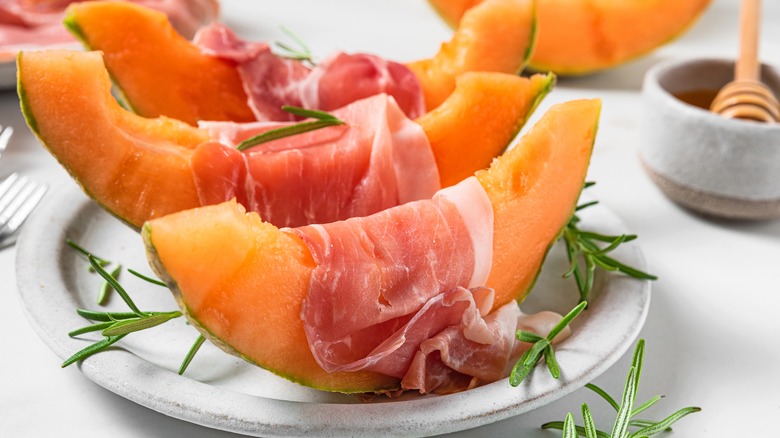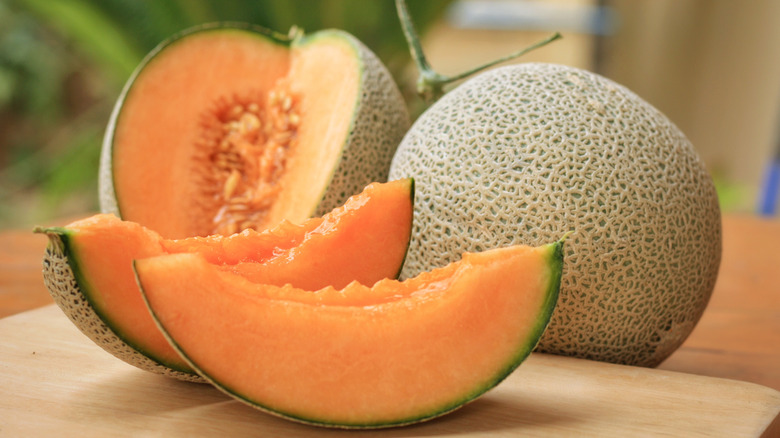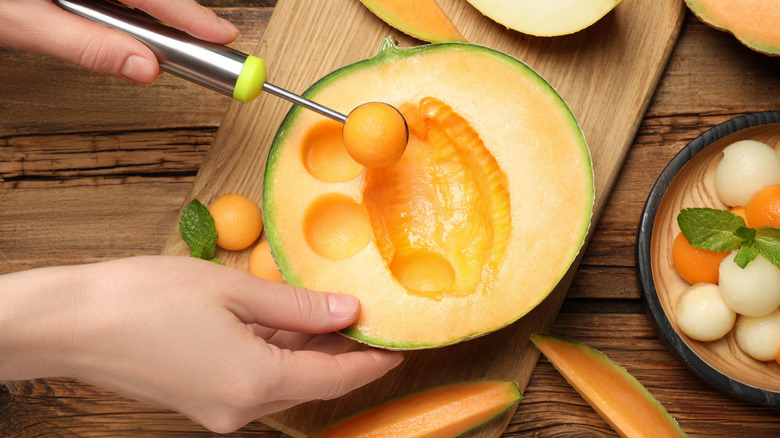What You Need To Know Before Attempting To Cut A Cantaloupe
There's nothing quite as refreshing as biting into a slice of cantaloupe straight from the rind on a steamy summer afternoon. Cantaloupe is a variety of muskmelon (a species of melon that is part of the gourd family, along with honeydew melon) and is known and loved for its juicy sweetness and slightly firm but tender orange flesh. The versatile fruit makes for the perfect pairing in savory-sweet summertime dishes, such as melon and prosciutto pasta salad. It's also excellent when enjoyed for breakfast in a bowl of fruit salad or made into a smooth and creamy sorbet for dessert.
Though it might be tempting to cut right into an entire cantaloupe upon bringing your ripe fruit home, before you do, it's important to weigh that impulse against a cantaloupe's shelf life. Due to its high sugar and moisture content, once cut and exposed to air, cantaloupe is particularly susceptible to food spoilage. Cut cantaloupe will only last two to three days cubed or up to five days sliced and stored in an airtight container in the fridge.
If you're preparing cantaloupe for a crowd and will eat it within a few days, go ahead and peel and slice or cube the fruit. However, if you want to extend the melon's shelf life, you'll need to refrain from peeling and cutting the whole thing, instead storing part of the melon for later use.
How to cut cantaloupe wisely
To cut a whole, ripe cantaloupe, start by cutting off both ends of the melon to create a flat surface to set it upon a cutting board stably. Then, working from top to bottom, carefully use a knife to slice away the peel, removing the net-like skin and any white or green areas between the skin and the orange flesh of the fruit. Once peeled completely, cut the melon in half, remove the seeds from each half with a spoon, and slice or cut the fruit into cubes.
Like summertime, it's essential to savor cantaloupe. To save part of the cantaloupe for later, only cut off the portion, peel, and prepare the part you want to eat fresh or use in a recipe. To prepare half of the cantaloupe, slice it down the middle and then reserve half of the melon (with the seeds left intact) by covering it in plastic or beeswax wrap, wrapping it tightly to prevent exposure of the fruit to air. This will help extend its shelf life storage in the fridge.
Prepare the part you're ready to use by removing the peel and cutting the melon, or opt to leave the rind on and cut it into snack-able slices.
Making the most of the melon
Because of cantaloupe's susceptibility to spoilage, it's important to monitor the sensory aspects of the fruit to tell when it's ripe and whether it's still good to eat. You can tell a cantaloupe is ripe when it is golden in color, has a sweet aroma, and is firm but has a slight give to the touch at the base. Once you cut into a ripe melon, it will be sweet and juicy.
While ripe cantaloupe can sit out on the counter for a couple of days, it will spoil much quicker than it would if it were stored in the cold temperatures of the fridge. One way to extend the shelf life prior to cutting into the fruit is to transfer the melon directly to the fridge as soon as it's ripe. Stored in the fridge, uncut melon can last up to 21 days. Once cut, if the cantaloupe has been left too long and spoiled, it will smell fermented, have an unpleasant, sour taste, and have a mealy texture. Be sure to throw it away if you suspect your cantaloupe has gone too far.
If the cantaloupe is still good, but you realize you cut too much to eat in a few days, there are still a few ways to prevent the fruit from going to waste. Save your ripened fruit by puréeing and cooking it down into fruit butter or by freezing it in cubes.


